Invisibility is the best defense: building an internet within an internet
I believe most people want this technology so they can express themselves freely. It’s a comfortable feeling when you know you can do that. At the same time we can conquer some of the problems seen within the Internet by changing the way security and privacy is viewed, as well as the extent to what it is valued.
In October 2001, 0x90 ( Lance James) had a dream. It started as a “desire for instant communication with other Freenet users to talk about Freenet issues, and exchange Freenet keys while still maintaining anonymity, privacy and security.” It was called IIP — the Invisible IRC Project.

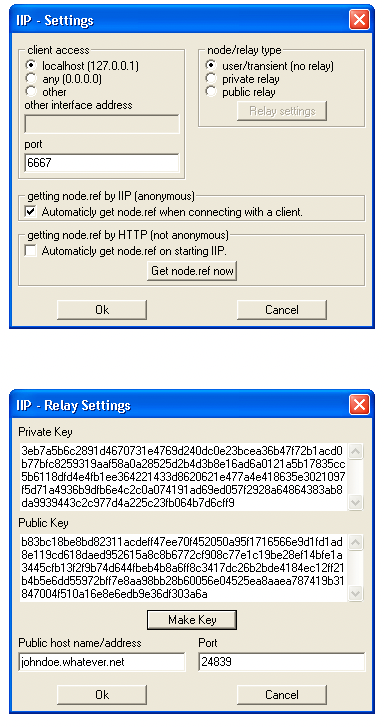
The Invisible IRC Project was based on an ideal and framework behind The InvisibleNet:
In an interview from 2002, 0x90 described the project:
“InvisibleNet is a research & development driven organization whose main focus is the innovation of intelligent network technology. Our goal is to provide the highest standards in security and privacy on the widely used, yet notoriously insecure Internet."
"The InvisibleNet team is comprised of a talented group of developers and architects entirely dedicated to providing its users with both convenience and the very best in secure communication."
"Our technological ideals are reflected in the implementation of a framework that is solid in design, and transparent in its application."
"Here at InvisibleNet we strive towards the greatest level of quality possible by keeping all areas of our research & development open and available to the public for peer review, feedback, suggestions and new ideas.”
"The Invisible Internet Project: Defined as the “New Internet”. Peer 2 Peer Internet. Using your peers to protect you. It is a similar concept to the Invisible IRC Project, with its design as our test model. We plan to re-design the Internet by taking it a step further and having security and privacy be first priority."
"The Invisible Internet Project or Protocol will be utilizing the tests and research/development concepts of the Invisible IRC Project to give us the scalability that we need and leverage this to take it to the next level."
"This, in essence will be an impenetrable neural-network, that is self-driven, self-defensed, and completely seamless to already applied protocols, specifically client to server (or agents as I call them). It will be THE next transport layer, a layer on top of the notoriously insecure Internet, to deliver full anonymity, privacy, and security at the highest level possible. Decentralized and peer to peer Internet, by the way, means no more worrying about your ISP controlling your traffic. This will allow you to do seamless activities and change the way we look at security and even the Internet, utilizing public key cryptography, IP steganography, and message authentication. The Internet that should have been, will be soon."
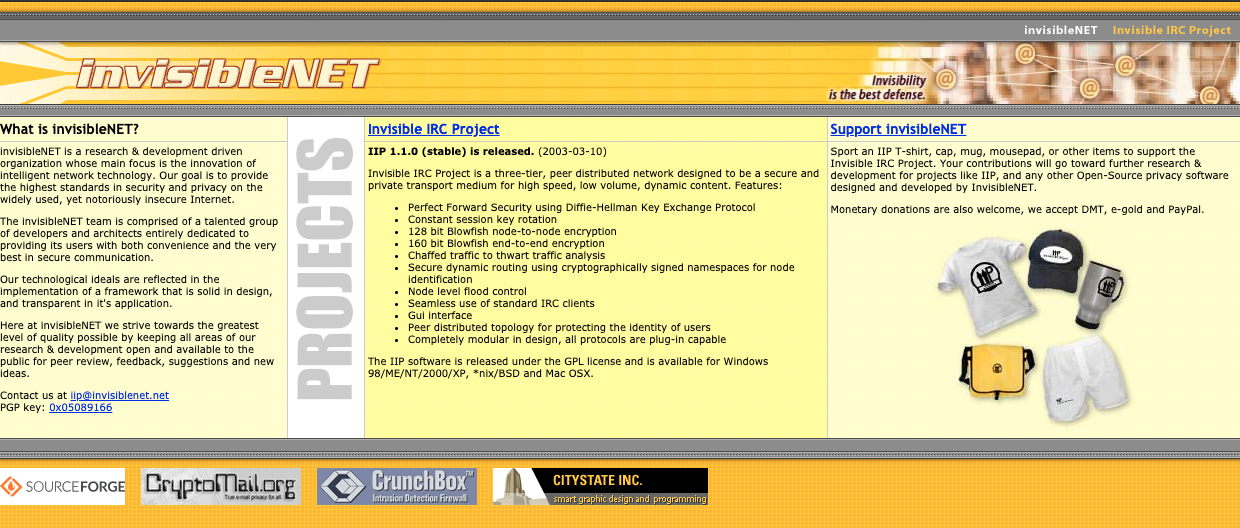
By 2003, several other similar projects had started, the largest being Freenet, GNUNet, and Tor. All of these projects had broad goals to encrypt and anonymize a variety of traffic. For IIP, it became clear that IRC alone was not a big-enough target. What was needed was an anonymizing layer for all protocols. IIP by now was also being called “InvisibleNet”.
In early 2003, a new anonymous developer, “jrandom” joined the project. His explicit goal was to broaden the charter of IIP.
jrandom wished to rewrite the IIP code base in Java, a language he was familiar with, and the same language Freenet was using. He also wished to redesign the IIP protocols based on recent papers and the early design decisions that Tor and Freenet were making. Some of these concepts and naming conventions, such as “onion routing”, were modified to become “garlic routing”. For several of the design decisions, jrandom made different choices than Tor did, including selecting different cryptographic primitives in a number of places. Many (but not all) of these choices turned out quite well. For some others, such as using unidirectional tunnels rather than Tor’s bidirectional tunnels, the benefits and trade-offs are still not well-studied.
jrandom also set out a clear vision for the architecture of the code. It would be a client/server model, with the server (i.e. the router) isolated from any “client” protocols. Clients such as web browsers, web servers, IRC clients and servers, and others, would communicate through the router using I2CP, the I2P Client Protocol.
jrandom also had strong opinions on the direction of the project and its philosophy. He was strongly committed to open source and free software. He explicitly set a goal of protection from organizations with “unlimited financial and political resources.”
By late summer 2003, jrandom had taken control of the project, and renamed it the Invisible Internet Project or “I2P”. He published a document outlining the philosophy of the project, and placed its technical goals and design in the context of mixnets and anonymizing layers. He also published the specification of two protocols (I2CP and I2NP) and their underlying data structures, that formed the basis of the network I2P uses today. Lance (“nop”) was last seen in a project meeting on November 11, 2003.

https://www.bloomberg.com/news/articles/2003-09-14/the-underground-internet

By fall 2003, I2P, Freenet, and Tor were rapidly developing. Business Week published an article on “The Underground Internet” which referenced InvisibleNet and discussed “darknets” extensively. jrandom released I2P version 0.2 on November 1, 2003, and continued rapid releases for the next 3 years. He maintained regular weekly meetings and status notes during this time. Several popular services and “respites” emerged during this time. Auto updates via clearnet HTTP became available in 2004.
Through 2004 and 2005, router development continued, and several “clients” or applications were added to the I2P package. “Mihi” wrote the first streaming protocol implementation and the i2ptunnel interface for configuring and starting client tunnels. “Susi” wrote the web mail and address book applications SusiMail and SusiDNS. Many people worked on the router console web interface. A bridge to make it easier for non-I2P clients to communicate over I2P, called “SAM” (Simple Anonymous Messaging) was added.
zzz had no preconceived plans to contribute to the project, and had never written a line of Java. He had maybe used IRC once. At this time, I2P was at version 0.5, with maybe a thousand users and three hard-coded floodfills. Forum.i2p and postman’s tracker were up and running at the time, and weekly meetings and status notes, and releases every couple of week were happening.
By summer 2005, zzz had set up two websites. The first was zzz.i2p, which over the years became a central resource for I2P development, and still is. The second was stats.i2p, the first site to gather statistics on I2P network performance and present graphs on both the network and individual routers. While the individual router statistics eventually had to be shut down due to the tremendous growth of the network, the overall performance graphs remain. We are not sure that he ever planned to become the release manger for almost 2 decades, but we are happy he did. The project has not only stayed active, it has thrived and scaled to the demands of its growth.
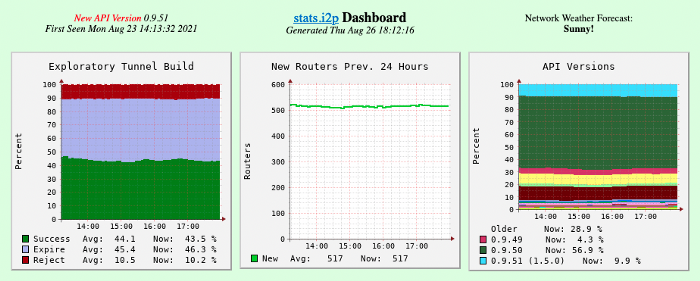
On July 27, 2005, jrandom released I2P version 0.6, including an innovative new UDP transport protocol he designed called “SSU”, for Secure Semi-reliable UDP. It contained features for IP discovery and firewall traversal.
In September 2005, jrandom bundled “Syndie”, his new high-latency anonymous messaging system. In October 2005, jrandom ported Snark, a Java BitTorrent client, to become an I2P application and bundled it with the I2P package. This completed the collection of client applications that are still bundled with I2P today.
In late 2005 and early 2006, jrandom redesigned the way that I2P built tunnels. This was a major effort that was done to increase the security of the tunnel building, which is crucial to maintain anonymity and resist attacks. He worked closely with the Freenet developers, including “Toad”, on this design. The new build protocol required new I2NP messages and a hard cut-over or “flag day”. These changes were released in version 0.6.1.10 on February 16, 2006. This is significant as it is the last flag day I2P has had. While, in practice, an 0.6.1.10 router would not work well, if at all, in today’s network, we are, technically speaking, backwards-compatible with this ten-year-old version today.
By early 2006, the I2P software was at least feature-complete, but it was still not widely-known. jrandom’s view was that it shouldn’t be marketed publicly until it was near-perfect, and labeled as version 1.0. The network had perhaps a thousand users at the time. Project members were discouraged from talking about it online, and the website (i2p.net) was unpolished and incomplete.
On July 27, 2006, jrandom released I2P version 0.6.1.23, including an innovative new TCP transport protocol he designed called “NTCP”, for new-IO-based TCP. It used Java’s new IO library for efficient handling of large numbers of TCP connections.
In late 2006, jrandom turned his focus to Syndie. He came to see it as his top priority, and the “killer application” for I2P. Highly secure and almost unusable, it delayed messages for up to two days before delivery to resist traffic analysis. Later in 2006, he stopped work on the bundled Syndie application and started a new, incompatible, standalone messaging application. This application was, confusingly, also called “Syndie”. The new Syndie was a large and complex development, and it was essentially a one-man project.
From late 2006 into 2007, core I2P development and releases slowed dramatically. From almost 30 releases in 2005 and 13 in the first half of 2006, there were only 5 in the second half of 2006 and only 4 in all of 2007. During this time, zzz and a developer named Complication had source code commit privileges and were making changes, but their understanding of the code base was limited. zzz worked, for example, on improving i2psnark, fixing bugs, and redesigning the strategy for anticipatory tunnel building. But there was a lot more that needed to be done. Complication and zzz did what they could, and they wrote the code for almost all the changes in the four 2007 releases (0.6.1.27–0.6.1.30). By this time, jrandom was providing very little guidance, code review, or direction for the project.
It wasn’t apparent at the time, but the project was in trouble.
jrandom had almost stopped working on the core I2P router and applications. Even the new Syndie, which he had declared as far more important than I2P itself, languished. After regular releases through March 2007, his next Syndie release, 1.100a, was August 25, 2007. All I2P releases were required to be signed by jrandom’s key, and he built and signed his last release, 0.6.1.30, on October 7, 2007.
In November 2007, disaster struck. Complication and zzz received a cryptic message from jrandom, that he would have to take time off from both Syndie and I2P development for a year or more. He expected that he would still be available to sign releases, but was willing to pass the release signing key to somebody else. Complication and zzz immediately replied with a request for the release key and other credentials, such as access to the website, mailing list, CVS administration, and others. Unfortunately, they never heard from jrandom again.
Late 2007 and early 2008, they awaited jrandom’s response, and wondered what to do next. However, all of the project infrastructure remained active, so it didn’t seem to be an immediate crisis. They knew, however, that without the release key or website access, they would have to sign with new keys, host the files on a new website, and require everybody to manually update since their keys wouldn’t be recognized.
The second stage of the disaster happened on January 13, 2008. The hosting company for almost all i2p.net servers suffered a power outage, and they did not fully return to service. Only jrandom had the credentials required to restore service. In addition, the centralized CVS source control appeared to be down, so five years of source control history appeared to be lost. Luckily, the CVS server was up, only the name server for it was down. The full contents of the CVS archive was quickly downloaded.
The project realized that even though it claimed to be totally decentralized, it actually depended on a number of centralized resources, above all, on jrandom. Work was done throughout 2008 to decentralize the project, and distribute roles to a number of people. Additionally, it was realized that development had essentially stalled in 2007, because jrandom had stopped working on it, but had not delegated to other developers. Nobody had an overall understanding of the code base.
Complication continued to sign the releases through mid-2009, but his contributions declined as he focused on activism and other projects. Starting with release 0.7.6 on July 31, 2009, zzz would sign the next 49 releases.
In December 2008, zzz attended his first CCC, 25C3 in Berlin, and met other I2P project team members for the first time, including hottuna and welterde. The experience was overwhelming, and also humbling, as he struggled to explain I2P to others or answer even basic questions about its design and use of cryptography.
By mid-2009, zzz had come to understand the code base much better. Far from being complete or perfect, it was filled with problems and scalability issues. In 2009 the project experienced more network growth due to its anonymizing properties as well as its circumvention abilities. Participants appeared who were beginning to adopt the network for reasons like censorship and clearnet issues like blocking of popular services. For development gains, in-net auto updates became available for the software.

July 2010 zzz briefly presented I2P at the end of Adrian Hong’s presentation at HOPE XXXX. Adrian talked about how tech has helped expose human rights violations, and the need for defensive tools for activists. He urged that we all be ambassadors for all tech, stay on top of new tech, and keep the barrier low and educate people about how to use the tool we create.
He also talked about how we need many options for people to use, and asked how do we make it easier to support human rights, freedom of expression?
At the end of the talk, zzz was invited on stage to introduce I2P and give an overview of what the project was about. The same weekend, it was pointed out that the I2P documentation was not in great shape.
In Fall 2010, zzz declared a moratorium on I2P development until the website documentation was complete and accurate. It took 3 months to get it done.
Beginning in 2010, until COVID restrictions were put in place, zzz, ech, hottuna, and other I2P contributors have attended CCC ( Chaos Communications Congress) every year. Over the years, meeh, Zab, Sadie, LazyGravy, KYTV, IDK and others have made the trip to Germany to share tables with other projects and celebrate the end of a year of releases. The project looks forward to one day being able to meet up again and have an in-person yearly roadmap meeting.
Anoncoin, a digital cryptocurrency that focuses on privacy and anonymity for its users was created in 2013. It was the first coin that provided built-in support for I2P, as well as Tor that makes it impossible to determine the IP address of the user. The developers, including meeh, also ran organizations like Privacy Solutions, and provided infrastructure support to the I2P network by running services like outproxies and reseed servers.
I2PBote development started to take off again in 2014 when str4d began contributing to the project. Bote is a server-less email client — it stores email in a distributed hash table. Email is “automatically encrypted and digitally signed, which ensures no one but the intended recipient can read the email, and third parties cannot forge them.” ( https://i2pbote.xyz/). The project has existed since 2009.
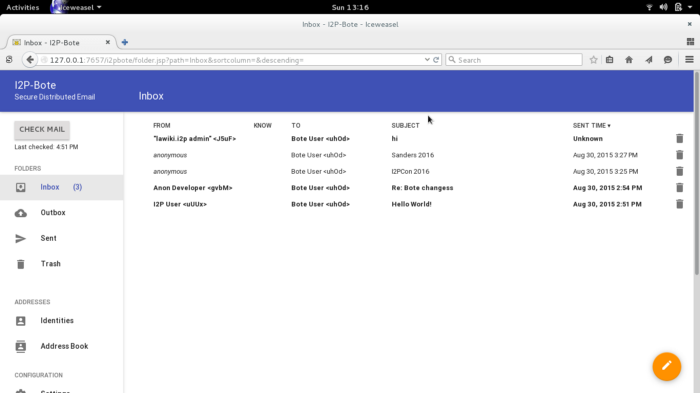
> I2PBote screenshot Credit: AceBarry
At Real World Crypto that year, zzz, psi and str4d began to talk about and review the plan to update I2P’s cryptography. The same year, the project was awarded a $5k donation from Duck Duck Go. Lavabit, SecureDrop, RiseUp and Mailpile also received donations for supporting better trust and privacy online.
By late 2014 most new signing crypto was complete, including ECDSA and EdDSA. New destination crypto was available; but new router info crypto needed to wait a year for the network to upgrade sufficiently.
During the early part of 2015, zzz posted to Twitter that it would be great to have a mini conference for I2P. In Spring, it was decided that I2PCon would take place that August over the course of a weekend.
Hottuna and Sadie organized most of the details, getting graphic assets created, posters printed and a banner made for the podium. Nick at Hacklab, where the event would take place, helped with making sure the space was ready for the event. Sadie reached out to the local infosec community and helped secure guest speakers as well. The event happened on one of the hottest weekends of the Summer, with attendees arriving from America and Europe. The I2P community did an amazing job of supporting the event by postering, giving talks, and spreading the word in forums and on social media. The talks can be viewed on KYTV’s YouTube Channel https://www.youtube.com/channel/UCZfD2Dk6POE-VU8DOqW7VVw
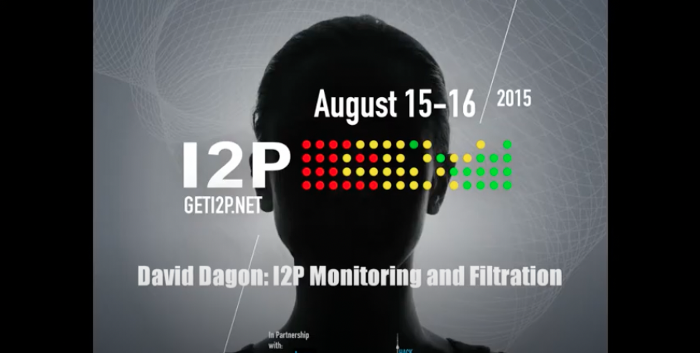
In January 2016 at Real World Crypto Stanford — str4d gave a talk on the crypto migration progress and future plans for the project. zzz and others would continue weekly meetings to plan the migration over the next few years.
NTCP2 was implemented in 2018, in release 0.9.36. It was disabled by default so that it could be tested. It was enabled in 0.9.37. NTCP1 was disabled in 0.9.40.
The new I2P transport protocol provides effective resistance against DPI censorship. It also results in reduced CPU load because of the faster, modern cryptography used. It makes I2P more likely to run on low-end devices, such as smartphones and home routers. Both major I2P implementations have full support for NTCP2 and it make NTCP2 available for use starting with version 0.9.36 (Java) and 2.20 (i2pd, C++).
The complete implementation details can be read here https://geti2p.net/en/blog/post/2018/08/20/NTCP2
0.9.39 included extensive changes for new network database types (proposal 123). The i2pcontrol plugin was bundled as a web-app to support development of RPC applications.
In 2019, the team decided to attend more conferences. That year IDK and zzz attended DefCon, and IDK gave a workshop on I2P application development. At Monero Village, zzz gave a talk called I2P for Cryptocurrency Developers.
Late that year, Sadie and IDK attended Our Networks in Toronto, where IDK gave a lightning talk about I2P.
Sadie attended RightsCon in Tunis and the Internet Freedom Festival in Valencia to meet with NGO’s and Human Right Defenders. Thanks to the the connections we made, the project received grants for usability and accessibility support from Open Tech Fund, and most recently Internews. This will ensure more user friendly onboarding, UX, and information architecture improvements to support the growing interest in the network. It will also support specific tooling to help in-need users with specific risk surfaces through user research.

That Summer, Hoàng Nguyên Phong had his research into I2P censorship accepted too FOCI at USENIX in Santa Clara. Sadie had supported the research and they attended together. I2P Metrics was created during this time https://i2p-metrics.np-tokumei.net/, and well as research into more resistant reseed servers for the I2P network https://homepage.np-tokumei.net/post/notes-i2p-reseed-over-cloudflare/. You can read the research report here https://homepage.np-tokumei.net/post/notes-otf-wrapup-blogpost/.
At CCC that year, the decision was made to migrate from Monotone too GitLab. The project was one of the last to use Monotone, and it was time to prepare to move on. IDK would spend 2020 ensuring the process was as smooth as it could be. The pandemic would result in the team not being able to see each other that year to celebrate the ( mostly) smooth move to Gitlab. On December 10. 2020, the project switched off the old mtn i2p.i2p branch, and moved the development of the core Java I2P libraries from Monotone to Git officially.
Congratulations and thanks to everyone who helped in the git migration, especially zzz, eche|on, nextloop, and our site mirror operators! While some of us will miss Monotone, it has become a barrier for new and existing participants in I2P development and we’re excited to join the world of developers using Git to manage their distributed projects.
https://geti2p.net/en/blog/post/2020/12/10/Hello-git-goodbye-mtn
0.9.47 enabled the new end-to-end encryption protocol (proposal 144) by default for some services. A Sybil analysis and blocking tool was also now enabled by default. 0.9.48 enabled the new end-to-end encryption protocol (proposal 144) for most services. Preliminary support was added for new tunnel build message encryption (proposal 152). There were significant performance improvements throughout the router.
0.9.49 was the release that brought faster crypto. The I2P network became faster and more secure. Improvements and fixes for the SSU (UDP) transport resulted in faster speeds. The release also started the migration to new, faster ECIES-X25519 encryption for routers. The project had been working on the specifications and protocols for new encryption for several years, and was getting close to the end of it. The migration would take several releases to complete.
To minimize disruption, only new installs and a very small percentage of existing installs (randomly selected at restart) would be using the new encryption.
The project had “rekeyed” the network twice before, when changing the default signature type, but this was the first time it had changed the default encryption type. 0.9.50 enabled DNS over HTTPS for reseeding to protect users from passive DNS snooping. There were numerous fixes and improvements for IPv6 addresses, including new UPnP support.
1.5.0 — The early anniversary release because it is so good!
Yes, that’s right, after 9 years of 0.9.x releases, we are going straight from 0.9.50 to 1.5.0. This does not signify a major API change, or a claim that development is now complete. It is simply a recognition of almost 20 years of work to provide anonymity and security for our users.
This release finishes implementation of smaller tunnel build messages to reduce bandwidth. We continue the transition of the network’s routers to X25519 encryption. Of course there are also numerous bug fixes and performance improvements.
As usual, we recommend that you update to this release. The best way to maintain security and help the network is to run the latest release.
Congratulations team. Let’s do another 20.


























